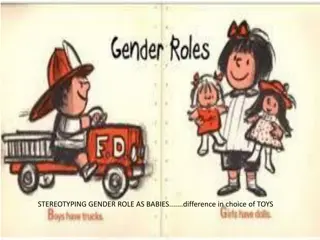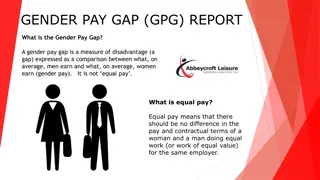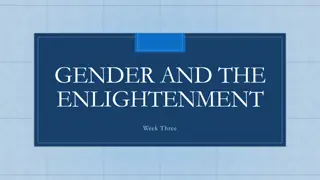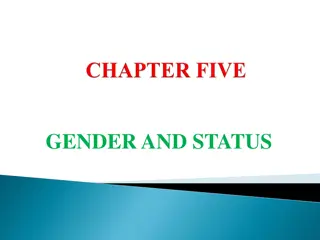Understanding Gender Perceptions in Language and Society
Words in various languages can reflect gender associations, influencing perceptions of men and women. Gender, distinct from biological sex, is a social construct that shapes societal attitudes. Proverbs and sayings offer insight into historical beliefs about the characteristics of men and women. Variations in language usage based on gender can further highlight societal norms and expectations.
Download Presentation

Please find below an Image/Link to download the presentation.
The content on the website is provided AS IS for your information and personal use only. It may not be sold, licensed, or shared on other websites without obtaining consent from the author. Download presentation by click this link. If you encounter any issues during the download, it is possible that the publisher has removed the file from their server.
E N D
Presentation Transcript
Words may refer to males or females, or to things that have become associated with these categories. In English, therefore, we find he and she , actor and actress , as well as some less obvious ascriptions that designate ships as feminine, for instance. Other languages also have a neuter gender (and, in English, it is a neuter pronoun). It can be difficult to understand some gender allocations: in German, for instance, knife (messer), fork (gabel) and spoon (l offel) are, respectively, neuter, feminine and masculine. In both French and Italian, the moon (lune, luna) is feminine, and the sun (sole, soleil) is masculine; in German, however, the moon (mond) is masculine and the sun (sonne) is feminine.
The current sense of gender as an indication of the masculine or feminine behaviour of men and women dates only from about 1960. It is usually, and usefully, distinguished from sex : biological characteristics define the latter, while gender, although built upon biological categorisation, is a social construction.
A good place to begin here is with the folk wisdom reflected in proverbs, sayings and quotations: these bear some relationship to the laws and mores of a society, and they can tell us something of social attitudes. Many of them encapsulate views of men and women.
These sorts of statements suggest an interesting difference in perceptions of men and women beyond the immediate and obvious one. The character of woman has traditionally been seen as more superficial, and as possessing less moral depth, than that of man: la donna `e mobile, after all. Women who seemed competent in matters of morals and intellect were generally regarded as anomalies, and their achievements were likely to be belittled.
The greatest variation, of course, would be found in a speech community in which men and women spoke different languages. It would indeed be odd to find men and women unable to understand each other s language, but there are situations in which women customarily speak languageA and men language B, and where the two sexes are bilingual. There are languages in which the sex of the listener rather than that of the speaker determines the variant used, and there are others in which the sex of both speaker and listener is influential.
Why do such differences exist? In some cases, social and religious taboos can have linguistic consequences. In others, women s forms appear to be older than the men s: changes have occurred in men s speech which the women have yet to adopt. It is a common observation that women s linguistic patterns tend, overall, to be more conservative than those of men. Related to this, and supporting the maintenance of distinctions, is the view expressed more in some cultures than in others that the older forms are better.
Findings within a speech community reveal that womens speech tends to be more standard than that of their male colleagues. An apparently contradictory finding is that, where a more prestigious variety is threatening a smaller one, and where language shift to the former is underway, women tend to be early shifters (see Scherer and Giles, 1979). But this seeming contradiction is resolved when we consider just why women s speech should be more standard than men s.Most explanations centre upon women s allegedly greater status-consciousness (Trudgill, 1983). If women are less socially secure than men, for example, they may wish to gain status through the use of more standard forms.
It has also been suggested that, with women traditionally less likely to be defined by markers of occupation and income, they may make their speech a sort of surrogate status marker; see also Trudgill (1972; 2000). They may also, in their maternal role, be more conscious of the importance of their children s acquisition of prestigious speech variants and thus, consciously or otherwise, see part of this role as linguistic model. Beyond this, there is also the already noted association between working-class speech and masculinity which, for males of all classes, can constitute so-called covert prestige . Research here has shown that males often claim to use more nonstandard forms than they actually do while females are more likely to over-report standard usage.
If womens and mens speech differs because the status (and hence, status- consciousness) of the genders differs, then it is clear that large social issues of power and subordination are involved. If women are expected to use better forms than men, if they are supposed to be more polite , if their use of profanity and obscenity is more severely sanctioned, then we might conclude that they are a subordinate group whose linguistic (and other) behaviour has limits placed upon it. It is an irony, of course, that the forms this limiting takes are often velvetlined: isn t it good to be polite and to avoid swearing? The fact remains, however, that if women are on some sort of linguistic pedestal in these regards, they have been placed there and pedestals offer little room for movement.
Subordinate social role implies less freedom of movement, greater insecurity, uncertainty and lack of confidence. It is exactly these features that were elucidated by Robin Lakoff (1973, 1975, 1990) in her much cited studies of women s language.
These include: (a) lexical hedges or fillers (you know, sort of, you see); (b) tag questions (she s very nice, isn t she); (c) emotional, expressive but often empty adjectives (divine, charming); (d) precise colour terms (magenta, taupe, mauve); (e) intensifiers (I like him so much); (f) excessive politeness, avoidance of commitment and indirect requests; (g) euphemisms and avoidance of swearing; (h) emphatic stress (it was a brilliant performance); (i) use of diminutive forms; (j) collaborative rather than competitive conversational style; (k) greater use of gesture and intonation (i.e. nonverbal or paralinguistic accompaniments); (l) breathier voice quality; (m) imprecision in diction.
More fine-grained analyses of gender differences in speech reveal that women s features, greater female politeness, increased use of standard variants and so on may all imply more about genuine facilitative and supportive desires than they do about insecurity and lack of confidence. The broader point, of course, is that men and women may use language for different social purposes, having been socialised in different ways from earliest childhood.
If we return for a moment to proverbial aphorism, the most general proposition is that speech may be silver, but silence is golden. It is better to remain silent and be thought a fool, said Abraham Lincoln, than to open one s mouth and remove all doubt. The picture here contrasts the garrulous ass with the strong, silent type, and there is the further suggestion that, with wisdom, one expects taciturnity. The German proverbial assertion about silver and gold (Reden ist Silber, Schweigen ist Gold) is amplified by the further note that talking is natural (and common), while silence is wise (and rarer): thus, Reden kommt von Natur, Schweigen vom Verstande. No prizes are awarded for deducing the gender linkages that have suggested themselves here.
Woman, the more natural of the sexes or genders (see above) is inevitably also more common ; wisdom thus comes less frequently to her than it does to man. Besides, lacking the physicality of men,women find that la langue est leur ep ee, and it is a sword that they will not let rust. This, despite the fact that they are so often reminded about that golden silence that not only reflects sagacity but also and even more importantly obedience and submission. Silence may be the best ornament of a woman, but it is one she all too seldom wears. In fact, however, there is abundant evidence that men talk more than women.

















































